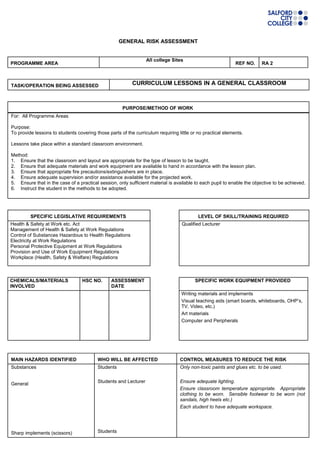
Risk Assessment for Classroom Lessons
- 1. GENERAL RISK ASSESSMENT All college Sites PROGRAMME AREA REF NO. RA 2 TASK/OPERATION BEING ASSESSED CURRICULUM LESSONS IN A GENERAL CLASSROOM PURPOSE/METHOD OF WORK For: All Programme Areas Purpose: To provide lessons to students covering those parts of the curriculum requiring little or no practical elements. Lessons take place within a standard classroom environment. Method: 1. Ensure that the classroom and layout are appropriate for the type of lesson to be taught. 2. Ensure that adequate materials and work equipment are available to hand in accordance with the lesson plan. 3. Ensure that appropriate fire precautions/extinguishers are in place. 4. Ensure adequate supervision and/or assistance available for the projected work. 5. Ensure that in the case of a practical session, only sufficient material is available to each pupil to enable the objective to be achieved. 6. Instruct the student in the methods to be adopted. SPECIFIC LEGISLATIVE REQUIREMENTS LEVEL OF SKILL/TRAINING REQUIRED Health & Safety at Work etc. Act Qualified Lecturer Management of Health & Safety at Work Regulations Control of Substances Hazardous to Health Regulations Electricity at Work Regulations Personal Protective Equipment at Work Regulations Provision and Use of Work Equipment Regulations Workplace (Health, Safety & Welfare) Regulations CHEMICALS/MATERIALS HSC NO. ASSESSMENT SPECIFIC WORK EQUIPMENT PROVIDED INVOLVED DATE Writing materials and implements Visual teaching aids (smart boards, whiteboards, OHP’s, TV, Video, etc.) Art materials Computer and Peripherals MAIN HAZARDS IDENTIFIED WHO WILL BE AFFECTED CONTROL MEASURES TO REDUCE THE RISK Substances Students Only non-toxic paints and glues etc. to be used. Students and Lecturer Ensure adequate lighting. General Ensure classroom temperature appropriate. Appropriate clothing to be worn. Sensible footwear to be worn (not sandals, high heels etc.) Each student to have adequate workspace. Sharp implements (scissors) Students
- 2. Instruction given to students regarding hazards present within the classroom. Art materials and implements to be kept out of reach of students when not in use. A person qualified to administer first aid should be identifiable and available. First aid box must be available and stocked according to the list supplied. Electricity Students and Lecturer All mains powered portable electrical appliances to be in good working order and tested for electrical safety. Leads should be visually examined for damage before using. Damaged electrical leads must not be used. Equipment must be removed from service and repaired before re-use. Avoid trailing leads around edges of furniture or equipment that may cause damage. When transporting equipment, take care not to damage the lead. Mains leads etc. not to be permitted to trail across walkways, near heated surfaces etc. Each item of electrical equipment to have its own 240 volt socket. All 240 volt outlets to be connected via an ELCB or equivalent. Manual handling Students Where moving equipment may involve risk to students (e.g. moving music equipment), an assessment must be undertaken to establish a safe working procedure for lifting and carrying. Slip/Trip hazards Students and Staff Keep all gangways clear of obstructions. Coats, bags etc. to be hung on pegs. Floors to be maintained in good, clean condition, without missing tiles, rips in linoleum etc. Trailing leads not permitted to cross travel areas etc. Materials to be stacked safely out of travel areas. Keep floors and gangways dry and free from slip hazards. Clear up any spillage’s immediately. Fire Students and Staff Fire escape routes and exits to be kept clear of obstructions at all times and clearly marked with approved signs. Fire extinguishers and alarm points to be kept clear of obstruction at all times. Learners to be instructed in emergency evacuation procedure. MANUAL HANDLING RISK PERSONAL PROTECTIVE EQUIPMENT REQUIRED Has a manual handling risk been identified? YES N/A Is the risk considered to be Low Is a further detailed assessment required? NO If the answer to the above question is YES a separate manual Is training and instruction required NO handling assessment will be required to fulfil the requirements of Is there need for special accommodation NO the Manual Handling Operations Regulations 1992. Is there need for test/examination NO Is all P. P. E. compatible N/A FREQUENCY OF MONITORING ASSESSMENT REVIEW PERIOD N/A 3 6 Months 1 Year > 1 Year < 1 Year 2 Years 3 Years 4 Years >4 M Years o nt hs X X